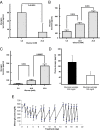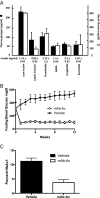Glucagon receptor antibody completely suppresses type 1 diabetes phenotype without insulin by disrupting a novel diabetogenic pathway
- PMID: 25675519
- PMCID: PMC4345619
- DOI: 10.1073/pnas.1424934112
Glucagon receptor antibody completely suppresses type 1 diabetes phenotype without insulin by disrupting a novel diabetogenic pathway
Erratum in
-
Correction for Wang et al., Glucagon receptor antibody completely suppresses type 1 diabetes phenotype without insulin by disrupting a novel diabetogenic pathway.Proc Natl Acad Sci U S A. 2015 Jul 28;112(30):E4158. doi: 10.1073/pnas.1512209112. Epub 2015 Jul 1. Proc Natl Acad Sci U S A. 2015. PMID: 26134395 Free PMC article. No abstract available.
Abstract
Insulin monotherapy can neither maintain normoglycemia in type 1 diabetes (T1D) nor prevent the long-term damage indicated by elevated glycation products in blood, such as glycated hemoglobin (HbA1c). Here we find that hyperglycemia, when unaccompanied by an acute increase in insulin, enhances itself by paradoxically stimulating hyperglucagonemia. Raising glucose from 5 to 25 mM without insulin enhanced glucagon secretion ∼two- to fivefold in InR1-G9 α cells and ∼18-fold in perfused pancreata from insulin-deficient rats with T1D. Mice with T1D receiving insulin treatment paradoxically exhibited threefold higher plasma glucagon during hyperglycemic surges than during normoglycemic intervals. Blockade of glucagon action with mAb Ac, a glucagon receptor (GCGR) antagonizing antibody, maintained glucose below 100 mg/dL and HbA1c levels below 4% in insulin-deficient mice with T1D. In rodents with T1D, hyperglycemia stimulates glucagon secretion, up-regulating phosphoenolpyruvate carboxykinase and enhancing hyperglycemia. GCGR antagonism in mice with T1D normalizes glucose and HbA1c, even without insulin.
Keywords: antibody; glucagon receptor; insulin; type 1 diabetes.
Conflict of interest statement
The authors declare no conflict of interest.
Figures



Comment in
-
Diabetes: New treatment approach for T1DM.Nat Rev Endocrinol. 2015 May;11(5):255. doi: 10.1038/nrendo.2015.29. Epub 2015 Mar 3. Nat Rev Endocrinol. 2015. PMID: 25732518 No abstract available.
References
-
- Derr R, Garrett E, Stacy GA, Saudek CD. Is HbA(1c) affected by glycemic instability? Diabetes Care. 2003;26(10):2728–2733. - PubMed
-
- Kozawa J, et al. Early postprandial glucagon surge affects postprandial glucose levels in obese and non-obese patients with type 2 diabetes. Endocr J. 2013;60(6):813–818. - PubMed
-
- Wang M-Y, et al. Iatrogenic hyperinsulinemia in type 1 diabetes: Its effect on atherogenic risk markers. J Diabetes Complications. 2013;27(1):70–74. - PubMed
Publication types
MeSH terms
Substances
Grants and funding
LinkOut - more resources
Full Text Sources
Other Literature Sources
Medical
Molecular Biology Databases

